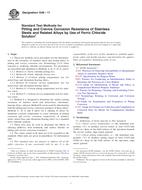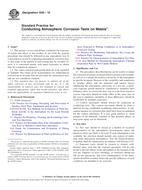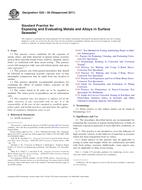Potrebujeme váš súhlas na využitie jednotlivých dát, aby sa vám okrem iného mohli ukazovať informácie týkajúce sa vašich záujmov. Súhlas udelíte kliknutím na tlačidlo „OK“.
ASTM E745-80(2009)
Standard Practices for Simulated Service Testing for Corrosion of Metallic Containment Materials for Use With Heat-Transfer Fluids in Solar Heating and Cooling Systems (Withdrawn 2018)
Automaticky preložený názov:
Štandardné postupy pre simulované testovanie služby pre korózie na kovová obalu reaktora materiálov pre použitie s pre prenos tepla kvapalín v solárny ohrev a chladenie
NORMA vydaná dňa 1.4.2009
Informácie o norme:
Označenie normy: ASTM E745-80(2009)
Poznámka: NEPLATNÁ
Dátum vydania normy: 1.4.2009
Kód tovaru: NS-47870
Počet strán: 8
Približná hmotnosť: 24 g (0.05 libier)
Krajina: Americká technická norma
Kategória: Technické normy ASTM
Kategórie - podobné normy:
Anotácia textu normy ASTM E745-80(2009) :
Keywords:
corrosion, field exposure, heat transfer fluids, immersion metallic containment materials, solar heating and cooling, Containment systems/applications, Corrosion--metals/alloys, Corrosion--solar devices, Field testing--solar materials, Heat transfer fluids, Immersion metallic containment materials, Simulated service test, Solar heating/cooling systems, ICS Number Code 77.060 (Corrosion of metals)
Doplňujúce informácie
| Significance and Use | ||
|
At this time none of these practices have been demonstrated to correlate with field service. Because these procedures do not restrict the selection of either the containment material or the fluid for testing, it is essential that consideration be given to the appropriate pairing of metal and fluid. Likewise, knowledge of the corrosion protection mechanism and the probable mode of failure of a particular metal is helpful in the selection of test conditions and the observation, interpretation, and reporting of test results. It is important that consideration be given to each of the permitted variables in test procedure so that the results will be meaningfully related to field performance. It is especially important that the time of testing selected be adequate to correctly measure the rate of corrosion of the containment material. Note 1—Corrosion, whether general or localized, is a time-dependent phenomenon. This time dependence can show substantial nonlinearity. For example, formation of a protective oxide will diminish corrosion with time, while certain forms of localized attack accelerate corrosion with time. The minimum time required for a test to provide a corrosion rate that can be extrapolated for the prediction of long-term performance varies widely, depending on the selection of metal and fluid, and on the form of corrosion attack. Therefore, it is not possible to establish a single minimum length of test applicable to all materials and conditions. However, it is recommended that for the tests described in these practices, a test period of no less than 6 months be used. Furthermore, it is recommended that the effect of time of testing be evaluated to detect any significant time dependence of corrosion attack. It is essential for the meaningful application of these procedures that the length of test be adequate to detect changes in the nature of the fluid that might significantly alter the corrosivity of the fluid. For example, exhaustion of chemical inhibitor or chemical breakdown of the fluid may occur after periods of months in selected cycles of operation. Note 2—Many fluids that may be considered for solar applications contain additives to minimize the corrosivity of the fluid. Many such additives are useful only within a specific concentration range, and some additives may actually accelerate corrosion if the concentration falls below a critical level. Depletion kinetics can be a strong function of the exposed metal surface area. Therefore, for tests involving fluids with such additives, consideration must be given to the ratio of metal surface area to fluid volume as it may relate to an operating system. |
||
| 1. Scope | ||
|
1.1 These practices cover test procedures simulating field service for evaluating the performance under corrosive conditions of metallic containment materials in solar heating and cooling systems. All test results relate to the performance of the metallic containment material only as a part of a metal/fluid pair. Performance in these test procedures, taken by itself, does not necessarily constitute an adequate basis for acceptance or rejection of a particular metal/fluid pair in solar heating and cooling systems, either in general or in a particular design. 1.2 These practices describe test procedures used to evaluate the resistance to deterioration of metallic containment materials in the several conditions that may occur in operation of solar heating and cooling systems. These conditions include: (1) operating full flow; (2) stagnant empty vented; (3) stagnant, closed to atmosphere, non-draindown; and (4) stagnant, closed to atmosphere, draindown. 1.3 The recommended practices cover the following three tests: 1.3.1 Practice A—Laboratory Exposure Test for Coupon Specimens. 1.3.2 Practice B—Laboratory Exposure Test of Components or Subcomponents. 1.3.3 Practice C—Field Exposure Test of Components or Subcomponents. 1.4 Practice A provides a laboratory simulation of various operating conditions of solar heating and cooling systems. It utilizes coupon test specimens and does not provide for heating of the fluid by the containment material. Practice B provides a laboratory simulation of various operating conditions of a solar heating and cooling system utilizing a component or a simulated subcomponent construction, and does provide for heating of the fluid by the containment material. Practice C provides a field simulation of various operating conditions of solar heating and cooling systems utilizing a component or a simulated subcomponent construction. It utilizes controlled schedules of operation in a field test. 1.5 The values stated in inch-pound units are to be regarded as standard. The values given in parentheses are mathematical conversions to SI units that are provided for information only and are not considered standard. 1.6 This standard does not purport to address all of the safety concerns, if any, associated with its use. It is the responsibility of the user of this standard to establish appropriate safety and health practices and determine the applicability of regulatory limitations prior to use. For a specific safety precaution statement see Section 6. |
||
| 2. Referenced Documents | ||
|
Podobné normy:
Historická
1.5.2013
Historická
1.9.2011
Historická
1.9.2010
Historická
1.11.2011
Historická
1.5.2014
Historická
1.4.2010
Odporúčame:
Aktualizácia technických noriem
Chcete mať istotu, že používate len platné technické normy?
Ponúkame Vám riešenie, ktoré Vám zaistí mesačný prehľad o aktuálnosti noriem, ktoré používate.
Chcete vedieť viac informácií ? Pozrite sa na túto stránku.



 ASTM G46-94(2013)..
ASTM G46-94(2013).. ASTM G48-11
ASTM G48-11 ASTM G50-10
ASTM G50-10 ASTM G52-00(2011)..
ASTM G52-00(2011).. ASTM G61-86(2014)..
ASTM G61-86(2014).. ASTM G73-10
ASTM G73-10
 Cookies
Cookies
